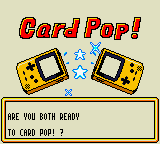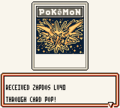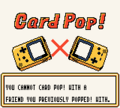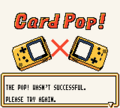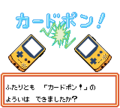Card Pop!: Difference between revisions
Rarecandybar (talk | contribs) m (→Mechanics: Probability typo) |
Rarecandybar (talk | contribs) m (→Trivia: Typo) |
||
| (6 intermediate revisions by 3 users not shown) | |||
| Line 3: | Line 3: | ||
==Hardware== | ==Hardware== | ||
[[File:Pokemon TCG Japanese cartridge PCB.jpg|thumb|150px|{{wp|Printed circuit board}} from the Japanese cartridge of {{vg|Pokémon Trading Card Game}}]] | [[File:Pokemon TCG Japanese cartridge PCB.jpg|thumb|150px|{{wp|Printed circuit board}} from the Japanese cartridge of {{vg|Pokémon Trading Card Game}}. The receiver and transmitter are the black and purple components, respectively, towards the top left and top right.]] | ||
In the American and European versions of this game, as well as in the [[Pokémon Trading Card Game 2: The Invasion of Team GR!]] (only released in Japan), this feature uses the infrared communications port of the [[Game Boy Color]]. | |||
In the Japanese version of | In the Japanese version of Pokémon Trading Card Game, the Card Pop! feature uses an infrared receiver and transmitter built into the cartridge itself. This means that, unlike the international version, it can be performed on an original [[Game Boy]], [[Game Boy Pocket]], or [[Game Boy Advance]]. It can also be used on a [[Game Boy Player]] for [[Nintendo GameCube|GameCube]]. However, it cannot be used on the [[Super Game Boy]] or [[Super Game Boy 2]] for the [[Super Nintendo Entertainment System|SNES]], nor the [[Game Boy Tower]] from [[Pokémon Stadium series]], with the game specifically telling the player that they cannot use Card Pop! on a Super Game Boy. | ||
In the | In the [[Nintendo 3DS]] [[Virtual Console]] release of Pokémon Trading Card Game, Card Pop! is disabled (like all multiple features). In the [[Nintendo Switch Online]] version, Card Pop! is emulated and can be performed. | ||
== | ==Mechanics== | ||
When two games are connected via infrared, each player will receive a random card. | When two games are connected via infrared, each player will receive a random card. This process can theoretically only be performed once with each partner. | ||
Card Pop! is the only way to obtain | Card Pop! is the only way to obtain the [[Phantom Cards]]: {{TCG ID|Promotional Card|Mew|PXX}} in Pokémon Trading Card Game, and {{TCG ID|Pokémon Card GB2|Lugia|promo}} and {{TCG ID|Team Rocket|Here Comes Team Rocket!|15}} in Pokémon Trading Card Game 2: The Invasion of Team GR!. While there were intended to be two Phantom Cards obtainable via Card Pop! in Pokémon Trading Card Game — Mew and {{TCG ID|Wizards Promo|Venusaur|13}} — due to an oversight in the code, Venusaur cannot be obtained this way (rendering it entirely unobtainable). | ||
===Pairing restrictions=== | |||
A player cannot Card Pop! with the same partner again until that player's ID is overwritten in their Card Pop! history. Only 16 players can be stored in the history at a time, so after both players have performed Card Pop! with 16 other players, they can perform Card Pop! with each other again. If the save file is deleted, all Card Pop! data is deleted and the player's ID number is reset, so the Card Pop! history of previous save files on the same cartridge has no impact on which players the new save file can perform Card Pop! with. | |||
Card Pop! partners are identified by their player name and a secret ID number. The secret ID number ranges from 0 to 65535, and is created at random when a new save file is created. This system is similar to the [[Trainer ID number|Trainer ID]] system in the [[core series]] games, although the ID number is not visible to the player. This means that even if two different players have the same in-game name, they will likely have distinct ID numbers and not be recognized as the same player by Card Pop!. | |||
In Pokémon Trading Card Game, if one player is allowed to Card Pop! but the other is not (i.e. the players have performed Card Pop! together before, and one player has overwritten the other from their history, but the other has not), then if they try to Card Pop!, the first player will actually receive a card, whereas the other will get Card Pop! denied. This happens due to a small programming bug when checking the name on each player's list of current partners. This oversight was fixed on Pokémon Trading Card Game 2: The Invasion of Team GR!. | |||
===Rewards=== | |||
The cards received are determined by the names and secret ID numbers of both players. If both players perform Card Pop! with enough other players to overwrite each other in their respective Card Pop! histories, performing it again will give the exact same rewards as the first time. | |||
When a player Card Pop! with another, first the rarity of the rewarded card is determined. Assuming two random | When a player performs Card Pop! with another, first the rarity of the rewarded card is determined separately. Assuming two random IDs, the probability of each category is given in the table below. | ||
{| class=" | {| class="roundtable" style="background: #{{colorschemelight|Kanto}}; margin-left: 5px; border: 3px solid #{{colorschemedark|Kanto}}" | ||
! style="background: #{{colorschemelight|Kanto}}; | ! style="background: #{{colorschemelight|Kanto}};" | Rarity | ||
! style="background: #{{colorschemelight|Kanto}}; | ! style="background: #{{colorschemelight|Kanto}};" | Probability | ||
|- | |- | ||
| Common | | Common | ||
| 102/256 (39.8 %) | | 102/256 (39.8%) | ||
|- | |- | ||
| Uncommon | | Uncommon | ||
| 90/256 (35.2 %) | | 90/256 (35.2%) | ||
|- | |- | ||
| Rare | | Rare | ||
| 63/256 (24.6 %) | | 63/256 (24.6%) | ||
|- | |- | ||
| Phantom Card | | Phantom Card | ||
| 1/256 (0.4 %) | | 1/256 (0.4%) | ||
|} | |} | ||
Once the rarity | Once the rarity of the card is determined, the player receives a card of the selected rarity. For Common, Uncommon, and Rare, the card is selected from the list of all cards in the game of that rarity, except {{tt|Energy|Basic Energy for Pokémon Trading Card Game 2: The Invasion of Team GR!}} and {{OBP|Promotional Card|TCG GB1|Promotional}} cards. For Phantom Cards, the player receives one of the two Phantom Cards. Each player's game determines which rarity and specific card they receive separately, so they will usually receive different cards, and even of different rarity. | ||
The selection of the card is effectively random, but based on a combination of the two players' names and secret IDs, so the cards received will not change if the same pair of players perform Card Pop! again (after overwriting each other from their Card Pop! history). However, in Pokémon Trading Card Game, due to an oversight, only one of the two Phantom Cards is obtainable — {{TCG ID|Promotional Card|Mew|PXX}} is the only obtainable Phantom Card, while {{TCG ID|Wizards Promo|Venusaur|13}} is unobtainable. This oversight was fixed in Pokémon Trading Card Game 2: The Invasion of Team GR!, so both of that game's Phantom Cards are obtainable. | |||
===New features from Pokémon Trading Card Game 2: The Invasion of Team GR!=== | |||
* In Pokémon Trading Card Game 2: The Invasion of Team GR!, once the player defeats {{TCG GB|Biruritchi}} for the first time, a variant of Card Pop! named '''Rare Card Pop!''' (Japanese: '''レアカードポン!''' ''Rare Card Pon!'') will be enabled. Its only difference with regular Card Pop! is that only rare cards are rewarded (255/256 probability), while retaining the Phantom Card chance of 1/256. Rare Card Pop! can only be used with another player using Rare Card Pop!. | |||
* The game also includes a Card Pop! record list of the last 99 Card Pop! and Rare Card Pop! partners names, along with both rewarded cards and current statistics from the partner (number of [[Event Coin|Event Coins]] earned, cards collected and battles fought). However, only the most recent 16 entries are checked for repeated Card Pop!. Rare Card Pop! entries are also highlighted with a star icon. | |||
* Finally, {{TCG GB|Ronald}} and [[Tomoaki Imakuni|Imakuni?]] also perform an in-game Card Pop! with the player. | |||
==Compatibility== | ==Compatibility== | ||
{{incomplete|section|needs=Does the Nintendo Switch Online version allow American and European games to communicate?}} | |||
Card Pop! cannot be performed between Pokémon Trading Card Game and Pokémon Trading Card Game 2: The Invasion of Team GR!. Attempting to do so can result in [[glitch]]es such as a [[game freeze]] or a loss of save data in Pokémon Trading Card Game.<!--even the Japanese version--> | Card Pop! cannot be performed between Pokémon Trading Card Game and Pokémon Trading Card Game 2: The Invasion of Team GR!. Attempting to do so can result in [[glitch]]es such as a [[game freeze]] or a loss of save data in Pokémon Trading Card Game.<!--even the Japanese version--> | ||
The Japanese version of | The Japanese version of Pokémon Trading Card Game cannot Card Pop! with a non-Japanese version. The infrared LEDs are misaligned between cartridge and Game Boy Color, physically preventing the two games from communicating. Additionally, their infrared communication protocols are different, so even if the games could receive each others' infrared signals, the games would not be able to understand each other. | ||
Conversely, the American and both European versions of Pokémon Trading Card Game can Card Pop! with each other. | |||
==Gallery== | ==Gallery== | ||
===Pokémon Trading Card Game=== | |||
<gallery> | <gallery> | ||
Card Pop position gbc.png|"Position the Game Boy Colors and press the A Button." | Card Pop position gbc.png|"Position the Game Boy Colors and press the A Button." | ||
Card_Pop_Received.png|"Received <card> through Card Pop!" | Card_Pop_Received.png|"Received <card> through Card Pop!" | ||
Card_Pop_Previous.png|"You cannot Card Pop! with a friend you previously Popped! with." | Card_Pop_Previous.png|"You cannot Card Pop! with a friend you previously Popped! with." | ||
Card_Pop_LinkError.png|"The Pop wasn't successful. Please try again." | Card_Pop_LinkError.png|"The Pop wasn't successful. Please try again." | ||
Card_Pop_Error_onlyGBC.png|Message when not using a Game Boy Color | Card_Pop_Error_onlyGBC.png|Message when not using a Game Boy Color | ||
Card_Pop_on_DMG_JP.png|Card Pop! working on an | Card_Pop_on_DMG_JP.png|Card Pop! working on an original Game Boy (Japanese version) | ||
Card_Pop_Error_NoSuperGameBoyJP.png|Card Pop! is not allowed on a Super Game Boy (Japanese version) | Card_Pop_Error_NoSuperGameBoyJP.png|Card Pop! is not allowed on a Super Game Boy (Japanese version) | ||
</gallery> | |||
===Pokémon Trading Card Game 2: The Invasion of Team GR!=== | |||
<gallery> | |||
Card_Pop_2_Screen.png|Card Pop! Screen | |||
Card_Pop_2_Rare_Screen.png|Rare Card Pop! Screen | |||
Card_Pop_2_Record.png|Record of a recent Card Pop! | |||
</gallery> | </gallery> | ||
==Trivia== | ==Trivia== | ||
* In practice, the Card Pop! outcome is one out of | * In practice, the Card Pop! outcome is one out of 32,768 possible results at random, but not all cards have the same chances of being selected. In Pokémon Trading Card Game, although the Phantom Card {{TCG ID|Promotional Card|Mew|PXX}} is only obtainable via Card Pop! with a 1/256 chance, it is not the rarest card to obtain by this method. In fact, {{TCG ID|Base Set|Super Energy Removal|79}} is the least frequent of all possible Card Pop! cards, with a 3/32,768 chance. The most probable card to receive through Card Pop! is {{TCG ID|Fossil|Arbok|31}}, with a 315/32,768 chance. Of course the rarity category probabilities do play an effect, but these differences also have to do with how the pseudo-random number generator works and how it affects the card shuffling mechanism. <!-- this is only verified on the American version via a simulation. Although the card lists and Card Pop random generation are exactly the same for all versions. Only the infrared communication is different.--> In Pokémon Trading Card Game 2: The Invasion of Team GR!, as there is near twice as many cards, many of the elegible cards are virtually unobtainable via Card Pop!. | ||
==In other languages== | ==In other languages== | ||
Latest revision as of 22:52, 10 September 2024
Card Pop! (Japanese: カードポン! Card Pon!) is a multiplayer feature in the video games Pokémon Trading Card Game and Pokémon Trading Card Game 2: The Invasion of Team GR!. This can be used to briefly connect two games through infrared, causing each game to receive a random card.
Hardware

In the American and European versions of this game, as well as in the Pokémon Trading Card Game 2: The Invasion of Team GR! (only released in Japan), this feature uses the infrared communications port of the Game Boy Color.
In the Japanese version of Pokémon Trading Card Game, the Card Pop! feature uses an infrared receiver and transmitter built into the cartridge itself. This means that, unlike the international version, it can be performed on an original Game Boy, Game Boy Pocket, or Game Boy Advance. It can also be used on a Game Boy Player for GameCube. However, it cannot be used on the Super Game Boy or Super Game Boy 2 for the SNES, nor the Game Boy Tower from Pokémon Stadium series, with the game specifically telling the player that they cannot use Card Pop! on a Super Game Boy.
In the Nintendo 3DS Virtual Console release of Pokémon Trading Card Game, Card Pop! is disabled (like all multiple features). In the Nintendo Switch Online version, Card Pop! is emulated and can be performed.
Mechanics
When two games are connected via infrared, each player will receive a random card. This process can theoretically only be performed once with each partner.
Card Pop! is the only way to obtain the Phantom Cards: Mew in Pokémon Trading Card Game, and Lugia and Here Comes Team Rocket! in Pokémon Trading Card Game 2: The Invasion of Team GR!. While there were intended to be two Phantom Cards obtainable via Card Pop! in Pokémon Trading Card Game — Mew and Venusaur — due to an oversight in the code, Venusaur cannot be obtained this way (rendering it entirely unobtainable).
Pairing restrictions
A player cannot Card Pop! with the same partner again until that player's ID is overwritten in their Card Pop! history. Only 16 players can be stored in the history at a time, so after both players have performed Card Pop! with 16 other players, they can perform Card Pop! with each other again. If the save file is deleted, all Card Pop! data is deleted and the player's ID number is reset, so the Card Pop! history of previous save files on the same cartridge has no impact on which players the new save file can perform Card Pop! with.
Card Pop! partners are identified by their player name and a secret ID number. The secret ID number ranges from 0 to 65535, and is created at random when a new save file is created. This system is similar to the Trainer ID system in the core series games, although the ID number is not visible to the player. This means that even if two different players have the same in-game name, they will likely have distinct ID numbers and not be recognized as the same player by Card Pop!.
In Pokémon Trading Card Game, if one player is allowed to Card Pop! but the other is not (i.e. the players have performed Card Pop! together before, and one player has overwritten the other from their history, but the other has not), then if they try to Card Pop!, the first player will actually receive a card, whereas the other will get Card Pop! denied. This happens due to a small programming bug when checking the name on each player's list of current partners. This oversight was fixed on Pokémon Trading Card Game 2: The Invasion of Team GR!.
Rewards
The cards received are determined by the names and secret ID numbers of both players. If both players perform Card Pop! with enough other players to overwrite each other in their respective Card Pop! histories, performing it again will give the exact same rewards as the first time.
When a player performs Card Pop! with another, first the rarity of the rewarded card is determined separately. Assuming two random IDs, the probability of each category is given in the table below.
| Rarity | Probability |
|---|---|
| Common | 102/256 (39.8%) |
| Uncommon | 90/256 (35.2%) |
| Rare | 63/256 (24.6%) |
| Phantom Card | 1/256 (0.4%) |
Once the rarity of the card is determined, the player receives a card of the selected rarity. For Common, Uncommon, and Rare, the card is selected from the list of all cards in the game of that rarity, except Energy and Promotional cards. For Phantom Cards, the player receives one of the two Phantom Cards. Each player's game determines which rarity and specific card they receive separately, so they will usually receive different cards, and even of different rarity.
The selection of the card is effectively random, but based on a combination of the two players' names and secret IDs, so the cards received will not change if the same pair of players perform Card Pop! again (after overwriting each other from their Card Pop! history). However, in Pokémon Trading Card Game, due to an oversight, only one of the two Phantom Cards is obtainable — Mew is the only obtainable Phantom Card, while Venusaur is unobtainable. This oversight was fixed in Pokémon Trading Card Game 2: The Invasion of Team GR!, so both of that game's Phantom Cards are obtainable.
New features from Pokémon Trading Card Game 2: The Invasion of Team GR!
- In Pokémon Trading Card Game 2: The Invasion of Team GR!, once the player defeats Biruritchi for the first time, a variant of Card Pop! named Rare Card Pop! (Japanese: レアカードポン! Rare Card Pon!) will be enabled. Its only difference with regular Card Pop! is that only rare cards are rewarded (255/256 probability), while retaining the Phantom Card chance of 1/256. Rare Card Pop! can only be used with another player using Rare Card Pop!.
- The game also includes a Card Pop! record list of the last 99 Card Pop! and Rare Card Pop! partners names, along with both rewarded cards and current statistics from the partner (number of Event Coins earned, cards collected and battles fought). However, only the most recent 16 entries are checked for repeated Card Pop!. Rare Card Pop! entries are also highlighted with a star icon.
Compatibility
Card Pop! cannot be performed between Pokémon Trading Card Game and Pokémon Trading Card Game 2: The Invasion of Team GR!. Attempting to do so can result in glitches such as a game freeze or a loss of save data in Pokémon Trading Card Game.
The Japanese version of Pokémon Trading Card Game cannot Card Pop! with a non-Japanese version. The infrared LEDs are misaligned between cartridge and Game Boy Color, physically preventing the two games from communicating. Additionally, their infrared communication protocols are different, so even if the games could receive each others' infrared signals, the games would not be able to understand each other.
Conversely, the American and both European versions of Pokémon Trading Card Game can Card Pop! with each other.
Gallery
Pokémon Trading Card Game
Pokémon Trading Card Game 2: The Invasion of Team GR!
Trivia
- In practice, the Card Pop! outcome is one out of 32,768 possible results at random, but not all cards have the same chances of being selected. In Pokémon Trading Card Game, although the Phantom Card Mew is only obtainable via Card Pop! with a 1/256 chance, it is not the rarest card to obtain by this method. In fact, Super Energy Removal is the least frequent of all possible Card Pop! cards, with a 3/32,768 chance. The most probable card to receive through Card Pop! is Arbok, with a 315/32,768 chance. Of course the rarity category probabilities do play an effect, but these differences also have to do with how the pseudo-random number generator works and how it affects the card shuffling mechanism. In Pokémon Trading Card Game 2: The Invasion of Team GR!, as there is near twice as many cards, many of the elegible cards are virtually unobtainable via Card Pop!.
In other languages
| ||||||||||||||||||

|
This article is part of both Project Sidegames and Project TCG, Bulbapedia projects that, together, aim to write comprehensive articles on the Pokémon Sidegames and TCG, respectively. | 
|
